As the winter months come closer, it’s time to start thinking about how best to care for your rubber boots. As someone who has gone through the process many times in my life, I want to provide some helpful tips on how to stretch rubber boots so that yours will fit perfectly when the cold weather hits!
My own experience with rubber boot stretching is an interesting one: while most methods were successful and gave me a perfect fit, there was one instance where attempts at home completely failed leading me to professional boot-stretching services something easily avoided but rarely thought about; So this post aims at helping readers steer away from frustration by providing essential steps which are simple yet effective ways of stretching your beloved boots!
Using a Boot Stretcher to Expand Your Rubber Boots:
I want to share my experience with stretching rubber boots to achieve a perfect fit.
During one of my camping trips, I found myself struggling with a pair of rubber boots that were uncomfortably snug. I decided to give boot stretchers a try. Here’s what I did:
Obtain a Boot Stretcher:
Purchase a high-quality rubber boot stretcher that fits the size of your boots.
Insert the Stretcher:
Place the boot stretcher inside the rubber boots, ensuring it reaches the toe area.
Expand the Stretcher:
Gradually rotate the stretcher’s knob to expand its width, gently stretching the rubber material.
Leave Overnight:
Allow the boots to sit overnight with the stretcher inside to ensure optimal stretching.
Test the Fit:
Try on the boots the next day to gauge the level of comfort. Repeat the process if necessary.
The Freezing Technique for Stretching Rubber Boots:
On another occasion, I discovered a unique method involving freezing to expand rubber boots. Here’s how it went:
Fill a Ziplock Bag:
Fill a ziplock bag halfway with water and seal it tightly, removing excess air.
Insert the Bag:
Place the filled ziplock bag inside the rubber boots, ensuring it fills the areas that need stretching.
Freeze the Boots:
Place the boots in the freezer, making sure they remain upright and do not fold or bend.
Allow Freezing Time:
Leave the boots in the freezer for at least 8 hours or overnight.
Thaw and Test the Fit:
Remove the boots from the freezer and let them thaw naturally. Once defrosted, try on the boots to check the improved fit.
Heat and Wear - An Effective Method to Stretch Rubber Boots:
During a memorable hiking trip, I discovered a method involving heat and wearing the boots to achieve the perfect fit. Here’s how it worked for me:
Apply Heat:
Using a hairdryer, I evenly heat the areas of the rubber boots that feel tight or need stretching. I kept the dryer on a low or medium heat setting to avoid damaging the material.
Wear Thick Socks:
I put on a pair of thick socks to protect your feet and create extra padding.
Put on the Boots:
While the boots are still warm, I carefully put them on and lace them up snugly.
Wear Them In:
I walk around in the boots for 15-20 minutes, allowing the heat and pressure from my feet to stretch the rubber.
Cool Down:
Once my feet have cooled down, I take off the boots and let them return to room temperature.
Through my personal experiences, I’ve discovered that these methods are effective in expanding rubber boots to achieve a more comfortable fit. So, feel free to explore these techniques and find the one that works best for you.
Potential Risks - What to Avoid When Stretching Rubber Boots?
However, I faced an unexpected challenge that taught me valuable lessons about the risks involved in stretching rubber boots.
Excessive Force and Pressure:
In my eagerness to achieve a better fit, I applied excessive force while stretching my rubber boots. This caused unnecessary strain on the material, resulting in tears and weakened areas. To avoid this risk, it’s crucial to be gentle and patient throughout the stretching process.
Overheating the Rubber:
During my attempt to stretch the boots, I used a heat source without considering the appropriate temperature. Unfortunately, I ended up overheating the rubber, causing it to melt and lose its shape. To avoid this risk, it’s essential to use low or medium heat settings and maintain a safe distance between the heat source and the boots.
Overstretching the Material:
In my excitement to achieve the desired fit, I stretched the rubber boots beyond their limits. This resulted in a loss of shape and durability, making the boots less effective in protecting my feet. To avoid this risk, it’s important to follow the recommended stretching methods and not exceed the maximum stretching capacity of the boots.
Sharp Objects and Excessive Force:
During my stretching attempt, I accidentally used a sharp object that punctured the rubber, causing irreparable damage. Additionally, I applied excessive force with stretching devices, leading to tears and deformation. To avoid these risks, be cautious of any sharp objects in your vicinity and avoid using excessive force when stretching rubber boots.
Caring for Your Stretched Rubber Boots - Maintenance Tips:
Let me share my experience and the maintenance tips I’ve learned along the way, they can help you as well!
- After every adventure or wear, it’s crucial to clean your rubber boots thoroughly. Use a gentle soap or specialized rubber boot cleaner and lukewarm water to remove any dirt, mud, or debris. Avoid harsh chemicals or abrasive cleaners that could damage the rubber.
- To keep your stretched rubber boots supple and prevent cracking or drying out, consider applying a rubber conditioner regularly. These conditioners provide nourishment and protect the rubber from UV rays, ozone, and other environmental factors.
- When not in use, store your stretched rubber boots in a cool, dry place away from direct sunlight. Exposure to extreme temperatures or sunlight can accelerate deterioration and affect the integrity of the rubber.
- While rubber boots are designed to withstand various environmental conditions, they can still be affected by prolonged exposure to chemicals. Avoid contact with gasoline, oil, solvents, fertilizers, and other harsh chemicals that can degrade the rubber. If accidental exposure occurs, rinse the boots immediately with water and mild soap to remove any residue.
- Regularly inspect your stretched rubber boots for signs of wear and tear. Look for cracks, splits, or any damage to the material. Additionally, check the soles for any signs of deterioration or loss of traction.
Conclusion:
I hope this information has been helpful for those of you struggling to break into a new pair. While it may take some time and effort to properly stretch your boots, it will be well worth it once they contour perfectly to your feet. Just remember to have patience, take breaks, and stop if you feel any pinching or numbness. Proper footwear is so important for comfort and safety, so invest the time upfront to ensure your boots fit like a glove. For best results, repeat these stretching techniques every few weeks as the material continues to soften over time.







